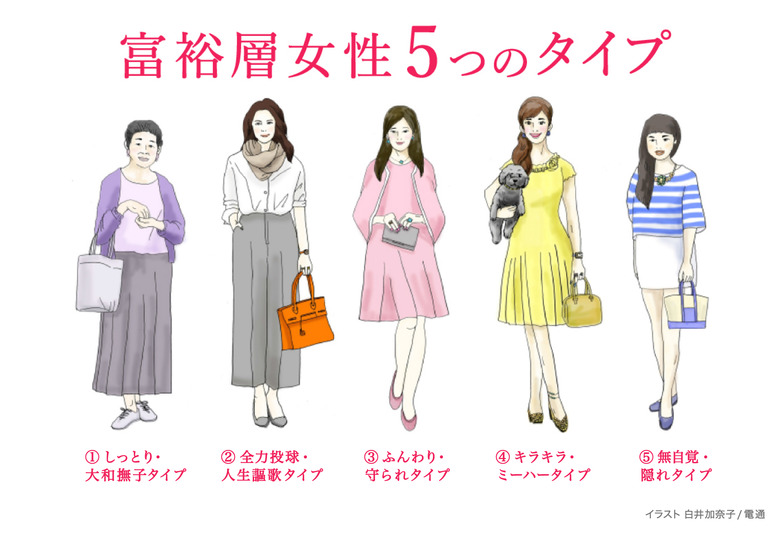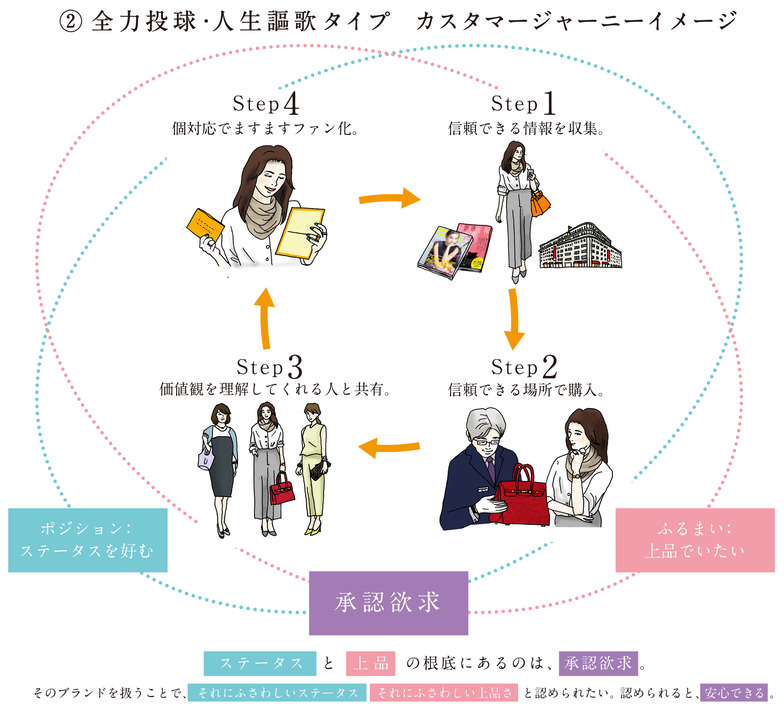By industry, inquiries came from luxury brands, financial institutions and credit card companies, automakers and cosmetics manufacturers dealing in high-end vehicles, tourism companies, and surprisingly, also from food, home appliance, and musical instrument manufacturers, e-commerce operators, and NPOs engaged in charitable activities.
We tend to think of the affluent as being out of reach, like figures in the clouds. However, through this survey, the insights from Hearst Fujingaho, and speaking with various people during this project, we've come to understand that the key to reaching affluent women isn't anything special compared to general consumers. The crucial point is that they won't spend on things they don't find value in. In other words, the key is creating value that resonates with them. However, the nature of that value differs from the general public. Furthermore, as previously introduced in Dentsu Inc. Report, it has become clear that spending habits also vary slightly across five distinct clusters. As explained in the earlier publication, here's a brief recap of the five types:
① The Elegant, Traditional Japanese Woman Type fundamentally views inherited assets not as something to spend, but to protect. That said, they are not entirely non-consumers; they are the type who will spend money wisely on things they truly need.
② The Full-Throttle, Life-Celebrating Type enjoys both work and private life with full commitment, truly savoring life. As mentioned earlier regarding the NPO inquiry, this group also shows strong interest in charity and social contribution.
③ The Protected Type are high-earning husbands' wives who enjoy happiness while being protected. On the other hand, they harbor anxieties about the future and aging, showing a strong tendency to spend on maintaining and enhancing their status as "beautiful wives."
④ The Sparkling & Trendy Type prioritizes looking glamorous and adores aggressive, assertive men. With a strong desire for elegance, they spend on luxury brands and pets.
⑤ The Unaware/Hidden Type is unaware of their own affluence. Raised as ordinary people despite wealthy parents, their financial sense is closest to that of the average woman. They generally don't own high-end brands, but may possess one-of-a-kind luxury items like bags gifted by relatives.
Based on this analysis, you've also proposed value-added services, right?
Shimada: Yes. We received a request from a homebuilder to "show their model homes to affluent individuals." With advice from Editor-in-Chief Sogo of '25ans', we made a proposal. For instance, since model homes typically require visitors to remove their shoes, the key challenge was how to get affluent individuals to take off their shoes. Instead of standard slippers, we prepared special slippers exclusively for them. We also arranged limousine service instead of taxis for transportation, and for the meals provided during the tour, we invited chefs from Michelin-starred restaurants to prepare the food. This proposal effectively captured the key points of hospitality for the target audience, and the clients were extremely pleased.
Don't turn readers into a business; instead, leverage insights gained from readers to drive business.
Koyama: It's commonly said we're in an era of "providing value, not just selling products." This holds true for the affluent as well; they only spend on what they perceive as valuable. Conversely, if they don't see value, even the most luxurious brand becomes indistinguishable from fast fashion. However, the remarkable thing about the affluent is their ability to spend staggering amounts when they find value. Precisely because their spending impact is so significant, how we deliver that value becomes critically important.
Kasahara: While not all our services exclusively target the affluent, we always keep in mind keywords that resonate with them. For example: "escape from the ordinary," "one-of-a-kind," "social contribution," and "intellectual curiosity." We also host events as venues for special experiences. For instance, gatherings where you can exclusively enjoy a chef's cuisine in Japan that's typically only available in France. While this sometimes results in high-priced services, if the value is clearly recognized, we receive far more applications than we can accommodate.
Koyama: I believe magazines once built circulation by resonating with readers through the "angle" proposed by the editor-in-chief and editorial team. But now, with such value-providing platforms scattered across the web, magazines that merely aim for reader resonance are functionally weak. In that regard, I think Hearst Fujingaho excels at deepening bonds with readers while also seamlessly connecting to their ultimate "consumption." Is this a trend across the industry?
Shimada: There is a trend, exemplified by American publications like Kinfolk, where magazines themselves embody communities. They aren't just consumed as content; the readers surrounding the magazine interact with each other, forming a collective entity. I believe Hearst Fujingaho has built such deep trust with its readers precisely because, over its long history, it has gradually understood the affluent readers around it and continuously embodied that understanding in its magazines.
Koyama: I think a magazine's strength isn't just the "editor," but also the fact that it has "readers." By interacting with readers and deepening bonds, you can then leverage the insights gained to further expand your business.
Kasahara: Until recently, our means of knowing who read our magazines and what they felt were limited. Now, through e-commerce and digital channels, we can find clear touchpoints with users. That's precisely why I feel it's crucial to leverage insights gained from readers to enhance service quality.
The Key to Moving the Hearts of the Affluent: "Personalized Engagement"
Koyama: Currently, we're collaborating with Hearst Fujingaho to develop a customer journey for affluent individuals. A customer journey maps the triggers and emotional shifts that lead customers to make purchases, organized by scenario. This is a broad overview, but take a look.
What consistently defines affluent women is their preference for status befitting their age and social standing, coupled with a desire to maintain elegance. Underlying this is a need for recognition—the desire to be acknowledged as deserving of that status and as elegant. They seek reassurance through this recognition.
To achieve this, they meticulously gather and curate reliable information, purchasing only from trusted sources. While the general public collects price and reputation-based word-of-mouth information, affluent women possess firm convictions. They may consult experts in the field but never blindly accept word-of-mouth claims. They also don't actively share purchased items or services on social media, reserving such sharing for those who understand their values. Their use of social media isn't about flaunting to brand themselves; instead, they seek mutual validation within closed communities. Furthermore, when they are personally recognized as deserving of a particular brand or service, they tend to become even more devoted fans, leading to increased consumption.
Kasahara: "Appropriate for one's social standing" essentially means confirming one's status through consumption. Sharing only with those who recognize value also involves having others acknowledge one's status, so these are individuals who are highly conscious of their position. That's precisely why personalized attention, truly recognizing each person individually, is so crucial.

Koyama: The key to moving the hearts of affluent consumers is "personalized engagement." Fulfilling their need for recognition and status leads to further consumption. Previously, this role was handled by securities brokers or sales representatives, but personalized engagement is finally becoming achievable in the digital realm too.
Kasahara: In our case, we previously managed users vertically through our magazines. With digital adoption, we're no longer bound by those magazine silos. From a user-first perspective, it's crucial for Hearst Fujingaho to leverage digital fully and mobilize our entire company to enhance user satisfaction. Technologically, we can also deploy personalized services using digital tools, so we aim to pursue such initiatives going forward.
Koyama: You could call it "personalized mass communication." By leveraging digital, we can efficiently increase satisfaction for each individual, right?
Now, we plan to continue the affluent consumer project next fiscal year. In the first year, we identified five clusters through awareness-based analysis. Next, we want to delve into behavior-based analysis to understand how we can encourage these women to engage more in consumption.
Shimada: As Mr. Kasahara mentioned earlier, the strength of this project lies in providing solutions for affluent consumers from a user-first perspective. By distilling the maximum insights each magazine possesses—such as '25ans', 'Fujingaho', and 'Richesse'—into an essence and offering it to advertisers, we believe we can drive business success. So, if you're interested, please don't hesitate to reach out to us.
Kasahara: When considering what brings advertisers the greatest satisfaction, while getting users to purchase goods or services is part of it, I believe the ultimate goal is to turn users into fans of the advertiser. To achieve this, understanding users is crucial, and analyzing the satisfaction underlying their consumption is necessary. In future research, we aim to uncover these aspects as well.
Koyama: Yes. Beyond research, we plan to expand this project in various ways—through events creating reader touchpoints, product development proposals, and more. We look forward to your continued support.










